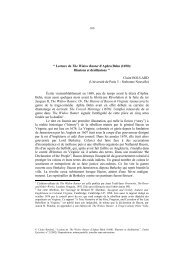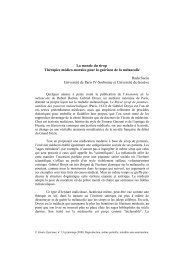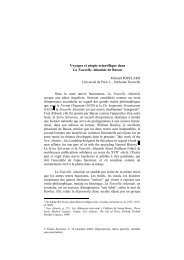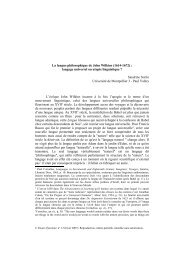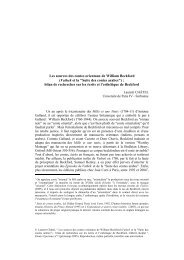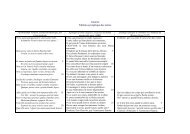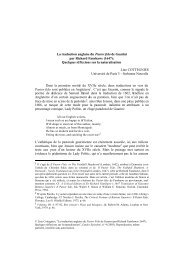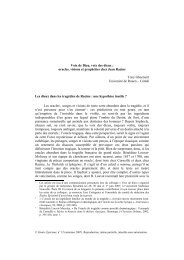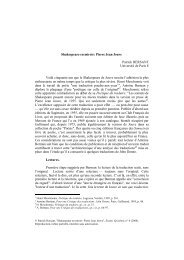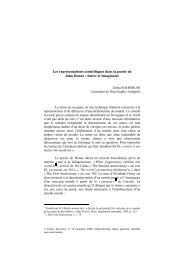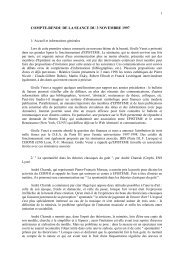« All flat maps, and I am one » : Cartographic References in the ...
« All flat maps, and I am one » : Cartographic References in the ...
« All flat maps, and I am one » : Cartographic References in the ...
You also want an ePaper? Increase the reach of your titles
YUMPU automatically turns print PDFs into web optimized ePapers that Google loves.
« <strong>All</strong> <strong>flat</strong> <strong>maps</strong>, <strong>and</strong> I <strong>am</strong> <strong>one</strong> » : <strong>Cartographic</strong> <strong>References</strong><strong>in</strong> <strong>the</strong> Poems of John DonneLadan NIAYESHUniversité de Paris 7 - JussieuAs A. E. Nordenskiöld rem<strong>in</strong>ds us, <strong>the</strong> <strong>maps</strong>, connected with<strong>the</strong> oldest editions of <strong>the</strong> Geography of <strong>the</strong> second centuryAlex<strong>and</strong>rian astronomer, ma<strong>the</strong>matician <strong>and</strong> geographer ClaudiusPtolemaeus, known as Ptolemy, "constitute <strong>the</strong> prototype of almost allgeographical atlases, published s<strong>in</strong>ce <strong>the</strong> discovery of <strong>the</strong> art ofpr<strong>in</strong>t<strong>in</strong>g" 1 . For a modern viewer, it is often hard to imag<strong>in</strong>ecartographers us<strong>in</strong>g anyth<strong>in</strong>g but <strong>the</strong> cartographic alphabet <strong>in</strong>heritedfrom Ptolemy, with, for <strong>in</strong>stance, <strong>the</strong> Ptolemaic orientation plac<strong>in</strong>g <strong>the</strong>north above <strong>and</strong> <strong>the</strong> east to <strong>the</strong> right. As Nordenskiöld goes on tonotice, <strong>the</strong> method of denot<strong>in</strong>g boundaries between l<strong>and</strong>s <strong>and</strong> seas,mounta<strong>in</strong> ranges, rivers <strong>and</strong> towns, used <strong>in</strong> old manuscripts ofPtolemy’s work <strong>and</strong> <strong>in</strong> his oldest pr<strong>in</strong>ted editions is still followed bycartographers today, with only slight variations. Yet, he objects, if wecompare our atlases, on <strong>the</strong> <strong>one</strong> h<strong>and</strong> with <strong>the</strong> <strong>maps</strong> of Ptolemy, <strong>and</strong>on <strong>the</strong> o<strong>the</strong>r h<strong>and</strong> with most medieval <strong>maps</strong> not <strong>in</strong>fluenced by <strong>the</strong>work of <strong>the</strong> Alex<strong>and</strong>rian geographer, we will f<strong>in</strong>d this cartographicalphabet to be at times as conventional <strong>and</strong> arbitrary as that of <strong>the</strong>primarily symbolic <strong>and</strong> dogmatic Mappae mundi produced <strong>in</strong> <strong>the</strong>West dur<strong>in</strong>g <strong>the</strong> Middle Ages.Despite m<strong>in</strong>or variations, most of those Medieval <strong>maps</strong>belong more or less <strong>in</strong>directly ei<strong>the</strong>r to <strong>the</strong> Macrobian or to <strong>the</strong>Tripartite or Noachid traditions 2 . Macrobian <strong>maps</strong> were n<strong>am</strong>ed after1 A. E. Nordenskiöld, Facsimile-Atlas to <strong>the</strong> Early History of Cartography (NewYork: Dover Publications, 1889 ; 1973), p. 1.2 For an ex<strong>am</strong>ple of a map related to <strong>the</strong> Macrobian tradition, see <strong>the</strong> woodcut madeafter John of Holywood’s 13th-century manuscript <strong>and</strong> reproduced <strong>in</strong> R. V. Tooley’sL<strong>and</strong>marks of Mapmak<strong>in</strong>g (Oxford: Phaidon, 1968 ; 1976), p. 14. For an ex<strong>am</strong>ple of aTripartite or Noachid map, see <strong>the</strong> earliest pr<strong>in</strong>ted world map, <strong>in</strong> an edition of Isidoreof Seville’s Etymologiarum (Augsburg : Gün<strong>the</strong>r Za<strong>in</strong>er, 1472), reproduced <strong>in</strong> David© Études Épistémè, n° 10 (automne 2006). Reproduction, même partielle, <strong>in</strong>terditesans autorisation
44Ladan Niayesch<strong>the</strong> Roman geographer Aurelius Macrobius, who lived at <strong>the</strong> end of<strong>the</strong> 4th <strong>and</strong> <strong>the</strong> beg<strong>in</strong>n<strong>in</strong>g of <strong>the</strong> 5th century. His Interpretatio <strong>in</strong>Somnium Scipionis conta<strong>in</strong>s, besides essays on different metaphysical<strong>and</strong> cosmographical topics, some geographical speculations <strong>in</strong> <strong>the</strong>second book, <strong>the</strong> mean<strong>in</strong>g of which was expla<strong>in</strong>ed by means of a map.Macrobius considered <strong>the</strong> (spherical) earth to be divided by <strong>the</strong> oceancurrents<strong>in</strong>to a series of more or less <strong>in</strong>habitable z<strong>one</strong>s or belts (five,or subsequently seven). The equatorial z<strong>one</strong> which separates <strong>the</strong>nor<strong>the</strong>rn <strong>and</strong> sou<strong>the</strong>rn hemispheres he considered to be a sea whichheat made impossible to cross, while <strong>the</strong> extreme cold of <strong>the</strong> north <strong>and</strong>south poles rendered those areas equally <strong>in</strong>hospitable <strong>in</strong> his view.Those three areas (equatorial sea, north <strong>and</strong> south poles) were seen byMacrobius as well as by many medieval authorities after him as <strong>the</strong>home of many monstrous races (<strong>one</strong>-eyed Cyclops, <strong>one</strong>-footedSciopods, dark-sk<strong>in</strong>ned Ethiops, Blemmyes bear<strong>in</strong>g <strong>the</strong>ir heads <strong>in</strong><strong>the</strong>ir chests, dim<strong>in</strong>utive Pygmies, monstrous Giants, etc.) whosephysical <strong>and</strong> consequently moral difformity was to be imputed to <strong>the</strong>extreme quality of <strong>the</strong> climates <strong>in</strong> which <strong>the</strong>y dwelled.The Tripartite or Noachid <strong>maps</strong>, also known as T-O <strong>maps</strong>, areso n<strong>am</strong>ed after <strong>the</strong>ir diagr<strong>am</strong>matic shape, which shows a circular, O-shaped ocean <strong>in</strong> which is <strong>in</strong>serted <strong>the</strong> letter T correspond<strong>in</strong>g to <strong>the</strong>three cont<strong>in</strong>ents of <strong>the</strong> ancient world l<strong>in</strong>ked toge<strong>the</strong>r. A variation on<strong>the</strong> s<strong>am</strong>e associates <strong>the</strong> letter T with <strong>the</strong> three great waterways wellknownto <strong>the</strong> Ancients, i.e. <strong>the</strong> Mediterranean sea, <strong>the</strong> Nile <strong>and</strong> <strong>the</strong>river Tanais (modern Don). Though pagan <strong>in</strong> orig<strong>in</strong>, Tripartite <strong>maps</strong>conveniently fitted <strong>in</strong> with Church teach<strong>in</strong>g <strong>and</strong> <strong>the</strong> belief <strong>in</strong> a divisionof <strong>the</strong> world after <strong>the</strong> Flood between <strong>the</strong> three sons of Noah (hence <strong>the</strong>n<strong>am</strong>e Noachid) : Japhet gett<strong>in</strong>g Europe, Ch<strong>am</strong> or H<strong>am</strong> receiv<strong>in</strong>gAfrica, <strong>and</strong> Shem <strong>in</strong>herit<strong>in</strong>g Asia. The letter T <strong>in</strong> <strong>the</strong>se highly edify<strong>in</strong>gbut not very realistic Mappae mundi was also fraught with symbolicmean<strong>in</strong>g, as its form recalled a cross, i.e. Christ’s cross. And <strong>in</strong>deed,<strong>in</strong> most of <strong>the</strong>se <strong>maps</strong>, Jerusalem, where Christ was crucified, wasplaced right at <strong>the</strong> <strong>in</strong>tersection of <strong>the</strong> three branches or cont<strong>in</strong>ents.These <strong>maps</strong> also greatly challenge our usual, Ptolemaically-receivedorientation, as <strong>the</strong> top position <strong>in</strong> <strong>the</strong>m is usually given to <strong>the</strong> east,where a graphic representation of <strong>the</strong> Garden of Eden is frequentlyplaced. Such is <strong>the</strong> case for <strong>one</strong> of <strong>the</strong> most f<strong>am</strong>ous ex<strong>am</strong>ples of a T-Omap, i. e. <strong>the</strong> Hereford Ca<strong>the</strong>dral map, drawn between 1275 <strong>and</strong> 1317Woodward (ed.), Five Centuries of Map Pr<strong>in</strong>t<strong>in</strong>g (Chicago <strong>and</strong> London : Universityof Chicago Press, 1975), p.9.© Études Épistémè, n° 10 (automne 2006).
45"<strong>All</strong> <strong>flat</strong> <strong>maps</strong>, <strong>and</strong> I <strong>am</strong> <strong>one</strong>"by Richard of Hald<strong>in</strong>gh<strong>am</strong> 3 . Circular <strong>in</strong> form, with <strong>the</strong> east at <strong>the</strong> top,it shows representations of Paradise, <strong>the</strong> Last Judgment, <strong>the</strong> Pillars ofHercules <strong>and</strong> numerous biblical <strong>and</strong> o<strong>the</strong>r legends. Jerusalem is <strong>in</strong> <strong>the</strong>center.The rediscovery of ancient Greek <strong>and</strong> Roman texts <strong>and</strong> <strong>maps</strong><strong>in</strong> <strong>the</strong> Renaissance (follow<strong>in</strong>g <strong>the</strong> fall of Constant<strong>in</strong>ople <strong>in</strong> 1453), <strong>the</strong>discovery of America by Christopher Columbus <strong>in</strong> 1492 <strong>and</strong> <strong>the</strong>subsequent exploration of <strong>the</strong> new cont<strong>in</strong>ent <strong>and</strong> <strong>the</strong> South seas byVespucci <strong>and</strong> o<strong>the</strong>rs, lead<strong>in</strong>g to Magellan’s circumnavigation <strong>in</strong> 1521,gradually supplant this medieval world vision <strong>and</strong> ultimately result <strong>in</strong><strong>the</strong> birth of modern geography as we know it. To Italy belongs <strong>the</strong>honour of be<strong>in</strong>g <strong>the</strong> first to revive an <strong>in</strong>terest <strong>in</strong> classic geography,with Ptolemy's Geographia be<strong>in</strong>g first pr<strong>in</strong>ted <strong>in</strong> Bologna (1477) 4 , <strong>and</strong><strong>the</strong>n <strong>in</strong> Rome (1478), Florence (1482) <strong>and</strong> Rome aga<strong>in</strong> (1490). In <strong>the</strong>century <strong>and</strong> a half that follow, European geographical atlases keep <strong>the</strong>Ptolemaic fr<strong>am</strong>e, but gradually add to it by <strong>in</strong>tegrat<strong>in</strong>g newgeographical data <strong>and</strong> do away with <strong>the</strong> picturesque but unscientificmonsters of <strong>the</strong> medieval <strong>maps</strong> to progressively adopt less allegorical,more scientific st<strong>and</strong>ards. Maps belong<strong>in</strong>g to this period of transition<strong>in</strong>terest<strong>in</strong>gly blend fact <strong>and</strong> fiction, <strong>in</strong>herited legends <strong>and</strong> newdiscoveries. A good ex<strong>am</strong>ple of such a phenomenon is provided bySimon Grynaeus’ atlas of 1532 <strong>in</strong>cluded <strong>in</strong> an edition of SebastianMünster’s Cosmographia universalis 5 . Here, <strong>the</strong> eastern coast of <strong>the</strong>American cont<strong>in</strong>ent is sketched most accurately, follow<strong>in</strong>g <strong>the</strong> latestf<strong>in</strong>ds of <strong>the</strong> European discoverers of <strong>the</strong> time, while <strong>the</strong> rest of <strong>the</strong>cont<strong>in</strong>ent is still a huge blank, wait<strong>in</strong>g to be explored <strong>and</strong> charted. Themonstrous shapes <strong>and</strong> wonders of many medieval <strong>maps</strong> are still <strong>the</strong>re<strong>in</strong> <strong>the</strong> shape of naked, cannibal races, Scythian warriors, an elephant<strong>and</strong> two basilisks, yet <strong>the</strong>se legends are removed from <strong>the</strong> centre <strong>and</strong>pushed back to <strong>the</strong> marg<strong>in</strong>s of <strong>the</strong> atlas.The geographical atlases of <strong>the</strong> sixteenth <strong>and</strong> seventeenthcenturies well reflect a fasc<strong>in</strong>at<strong>in</strong>g syncretic effort <strong>in</strong> front of <strong>the</strong>scientific discoveries of <strong>the</strong> time, an effort which is by no meanslimited to voyagers <strong>and</strong> cartographers. For history-makers <strong>and</strong>mapmakers as well as for <strong>the</strong>ir armchair-travell<strong>in</strong>g contemporaries,<strong>the</strong> old beliefs recede but slowly, while new data is adapted so as tocoexist with, <strong>and</strong> as much as possible fit <strong>in</strong> a received world picture.3 Reproduced <strong>in</strong> R. V. Tooley, Maps <strong>and</strong> Map-Makers (New York: Bonanza Books,1949; 1970), p. 9.4 Reproduced <strong>in</strong> L<strong>and</strong>marks of Mapmak<strong>in</strong>g, p. 51.5 Reproduced <strong>in</strong> Nordenskiöld, plate XLII.© Études Épistémè, n° 10 (automne 2006).
46Ladan NiayeschWritten mostly <strong>in</strong> <strong>the</strong> last decade of <strong>the</strong> sixteenth century <strong>and</strong> <strong>the</strong> firsttwo decades of <strong>the</strong> 17th century, <strong>the</strong> poetic works of John Donne wellillustrate this conceptual discordia concors.Let us take as a first ex<strong>am</strong>ple <strong>one</strong> of <strong>the</strong> last poems written byDonne, "Hymn to God my God, <strong>in</strong> my Sickness", composed ei<strong>the</strong>rdur<strong>in</strong>g <strong>one</strong> of <strong>the</strong> poet’s serious illnesses <strong>in</strong> 1623 or alternativelyshortly before his death <strong>in</strong> 1631 6 . Here <strong>the</strong> poet compares himself, ashe lies on his sick-bed, or possibly his death bed, to a <strong>flat</strong> geographicalmap studied by his physicians who are compared to cartographers:"my physicians by <strong>the</strong>ir love are grown / Cosmographers, <strong>and</strong> I <strong>the</strong>irmap, who lie / Flat on this bed" (ll. 6-8), <strong>and</strong> later "In all <strong>flat</strong> <strong>maps</strong>(<strong>and</strong> I <strong>am</strong> <strong>one</strong>)" (ll. 14).The cartographic tradition drawn on <strong>in</strong> this poem clearly bears <strong>the</strong>trace of <strong>the</strong> medieval T-O shaped <strong>maps</strong> correspond<strong>in</strong>g to <strong>the</strong> divisionof <strong>the</strong> world between <strong>the</strong> three sons of Noah, who are n<strong>am</strong>ed here :"Whe<strong>the</strong>r where Japhet dwelt, or Ch<strong>am</strong>, or Shem." (l. 20) The T-shaped form of <strong>the</strong> cont<strong>in</strong>ents with <strong>the</strong> symbolic reference to <strong>the</strong>crucifixion of Christ is also recalled here with <strong>the</strong> body of a dy<strong>in</strong>gpoet ly<strong>in</strong>g with his arms wide open : "We th<strong>in</strong>k that Paradise <strong>and</strong>Calvary, / Christ’s Cross, <strong>and</strong> Ad<strong>am</strong>’s tree, stood <strong>in</strong> <strong>one</strong> place; / LookLord, <strong>and</strong> f<strong>in</strong>d both Ad<strong>am</strong>s met <strong>in</strong> me." (ll. 21-23)Yet for all its symbolic Noachid <strong>and</strong> Christian background, Donne’scartographic imagery has room for <strong>the</strong> latest scientific contributions.Newly discovered territories are directly n<strong>am</strong>ed here: "is <strong>the</strong> PacificSea my home?" (l. 16), "Anyan, <strong>and</strong> Magellan, <strong>and</strong> Gibraltar" (l. 18) 7 .And if this metaphorical map is a <strong>flat</strong> <strong>one</strong> — "In all <strong>flat</strong> <strong>maps</strong> (<strong>and</strong> I<strong>am</strong> <strong>one</strong>)" — it is solely for <strong>the</strong> sake of commodity, as this <strong>flat</strong> shapeactually st<strong>and</strong>s for an acknowledged <strong>and</strong> accepted spherical reality:"west <strong>and</strong> east / In all <strong>flat</strong> <strong>maps</strong> (...) are <strong>one</strong>" (ll. 13-14).In modern <strong>maps</strong> what is figured at <strong>the</strong> extreme left is understood to beimmediately adjacent to what is to be found at <strong>the</strong> extreme right. Thepoet adopts <strong>and</strong> adapts this idea to his situation by tak<strong>in</strong>g <strong>in</strong>to accountall <strong>the</strong> symbolic weight of <strong>the</strong> west <strong>and</strong> east — <strong>the</strong> west be<strong>in</strong>g where<strong>the</strong> sun sets, <strong>and</strong> thus metaphorically associated with death, while <strong>the</strong>6 Edition used for this <strong>and</strong> all o<strong>the</strong>r quotes from poems by Donne: John Donne. TheComplete English Poems, ed. A. J. Smith (Harmondsworth : Pengu<strong>in</strong>, 1971 ; 1996).7 Anyan is possibly a deformation of Ann<strong>am</strong>, which was believed <strong>in</strong> Donne's day tobe located on a strait divid<strong>in</strong>g America from Asia. See Smith's note on this <strong>in</strong> hisedition, p. 665.© Études Épistémè, n° 10 (automne 2006).
47"<strong>All</strong> <strong>flat</strong> <strong>maps</strong>, <strong>and</strong> I <strong>am</strong> <strong>one</strong>"east is where <strong>the</strong> sun rises, a place diversely evok<strong>in</strong>g resurrection <strong>and</strong><strong>the</strong> siege of earthly Paradise: "As west <strong>and</strong> east / In all <strong>flat</strong> <strong>maps</strong> (<strong>and</strong> I<strong>am</strong> <strong>one</strong>) are <strong>one</strong>, / So death doth touch <strong>the</strong> resurrection." (ll. 13-15)Thus new discoveries are made to serve an age-old purpose, as <strong>the</strong>poet tries to surmount his fear of death <strong>and</strong> annihilation with <strong>the</strong>rational, scientific assurance that west <strong>and</strong> east, death <strong>and</strong> life are <strong>one</strong><strong>and</strong> <strong>the</strong> s<strong>am</strong>e accord<strong>in</strong>g to <strong>the</strong> new discoveries.With this assurance, he is ready for his voyage of exploration, even ifhe knows his journey will lead him to death <strong>in</strong> dangerous straits —"this is my south-west discovery / Per fretum febris, by <strong>the</strong>se straits todie" (ll. 9-10) — just as Magellan, <strong>the</strong> circumnavigator after whomMagellan’s Strait was n<strong>am</strong>ed, actually never f<strong>in</strong>ished hiscircumnavigation. He died <strong>in</strong> <strong>the</strong> South Seas on <strong>the</strong> way back whilehis <strong>one</strong> rema<strong>in</strong><strong>in</strong>g ship was brought back to Europe by his faithfullieutenant Sebastian El Cano.Although draw<strong>in</strong>g extensively on a medieval tradition, as wellas on modern cartographic discoveries, Donne <strong>in</strong> this poem, as well aselsewhere <strong>in</strong> his poetry, does not seem so much <strong>in</strong>terested <strong>in</strong>geographic exploration as <strong>in</strong> an exploration of <strong>the</strong> Self, with its fear ofdeath <strong>and</strong> hopes of salvation. Here as well as <strong>in</strong> many o<strong>the</strong>r poems,Donne is not tak<strong>in</strong>g sides <strong>in</strong> a scientific debate on <strong>the</strong> old <strong>and</strong> <strong>the</strong> new,but us<strong>in</strong>g both sides for a reflection on <strong>the</strong> Self, which constitutes <strong>the</strong>great subject of his poetry. "I <strong>am</strong> a little world cunn<strong>in</strong>gly made," hewrites <strong>in</strong> his Holy Sonnet 5. For him <strong>the</strong> macrocosm or larger universeappears mostly <strong>in</strong>terest<strong>in</strong>g as a source of imagery to convey ideas on<strong>the</strong> microcosm or <strong>the</strong> lesser universe of human body <strong>and</strong> m<strong>in</strong>d.At times, this complex, syncretic imagery leads him to whatJohn Carey calls "conceptual corners" 8 , i. e. unnaturally compositeimages or meet<strong>in</strong>g places for contraries, as <strong>in</strong> <strong>the</strong> f<strong>am</strong>ous open<strong>in</strong>gl<strong>in</strong>es of Holy Sonnet 7 : "At <strong>the</strong> round world’s imag<strong>in</strong>ed corners,blow/ Your trumpets, angels". If <strong>the</strong> world is viewed as round, howcan it have corners? This is a beautiful, typically metaphysical poeticconceit, i.e. an <strong>in</strong>tricate metaphorical figure which makes an <strong>in</strong>geniouscomparison between two apparently <strong>in</strong>congruous th<strong>in</strong>gs or concepts.The reference is possibly to <strong>the</strong> above-menti<strong>one</strong>d transition <strong>maps</strong>, <strong>in</strong><strong>the</strong> ve<strong>in</strong> of Grynaeus’s map, with an ovoid projection of <strong>the</strong> world at<strong>the</strong> center, surrounded by marg<strong>in</strong>al figures <strong>and</strong> gloss on a rectangular(cornered) sheet of paper. In many of <strong>the</strong>se <strong>maps</strong>, <strong>the</strong> marg<strong>in</strong>s are8 John Carey, John Donne : Life, M<strong>in</strong>d <strong>and</strong> Art (London <strong>and</strong> Boston : Faber <strong>and</strong>Faber, 1981 ; 1990), p. 247.© Études Épistémè, n° 10 (automne 2006).
48Ladan Niayeschoccupied, ei<strong>the</strong>r by picturesque images of <strong>the</strong> wonders of <strong>the</strong> world, orby w<strong>in</strong>ged images of blow<strong>in</strong>g figures, alternatively represent<strong>in</strong>g <strong>the</strong>different w<strong>in</strong>ds or heads of angels sound<strong>in</strong>g a trumpet so as to rem<strong>in</strong>dus that <strong>the</strong> end of <strong>the</strong> world is nigh 9 . This second version is probably<strong>the</strong> <strong>one</strong> from which Donne draws his apocalyptic image: "At <strong>the</strong> roundworld’s imag<strong>in</strong>ed corners, blow / Your trumpets, angels".Back to <strong>the</strong> idea of voyag<strong>in</strong>g <strong>and</strong> discover<strong>in</strong>g, <strong>one</strong> must notforget that <strong>in</strong> <strong>the</strong> context of <strong>the</strong> Great Voyages, exploration went h<strong>and</strong><strong>in</strong> h<strong>and</strong> with claim<strong>in</strong>g <strong>and</strong> tak<strong>in</strong>g possession. A central image <strong>in</strong>relation to this occurs <strong>in</strong> "A Valediction : of Weep<strong>in</strong>g", <strong>in</strong> Donne’sSongs <strong>and</strong> Sonnets. The image here is that of a cartographer past<strong>in</strong>gsheets of paper correspond<strong>in</strong>g to bits of <strong>maps</strong> on a round ball so as tomake a terrestrial globe : "On a round ball / A workman that hathcopies by, can lay / An Europe, Afric, <strong>and</strong> an Asia, / And quicklymake that, which was noth<strong>in</strong>g, all" (ll. 10-13). The image here is thatof a blank, empty surface which is little by little filled by man’sactivity shap<strong>in</strong>g <strong>and</strong> controll<strong>in</strong>g it. The poet likens this image to hisbeloved’s tears at his departure, as <strong>the</strong> world is reflected <strong>in</strong> hertransparent, round-shaped tear-drops. Here aga<strong>in</strong>, Donne’s conceitappears first <strong>and</strong> foremost as a conceit of <strong>the</strong> Self. The tear-drop hasno <strong>in</strong>terest <strong>in</strong> itself, just as <strong>the</strong> round, blank ball used by <strong>the</strong>cartographer has no <strong>in</strong>terest per se. The object ga<strong>in</strong>s mean<strong>in</strong>g thanksto <strong>the</strong> powerful h<strong>and</strong> of <strong>the</strong> explorer or cartographer add<strong>in</strong>g to it <strong>the</strong>latest discoveries of his m<strong>in</strong>d. Likewise, <strong>the</strong> tear-drop shed by <strong>the</strong>beloved is mostly used by <strong>the</strong> poet as a pretext, a mere mirrorreflect<strong>in</strong>g <strong>the</strong> surround<strong>in</strong>g world <strong>in</strong> general, <strong>and</strong> <strong>the</strong> poet st<strong>and</strong><strong>in</strong>g byher side <strong>in</strong> particular: "Draw not up seas to drown me <strong>in</strong> thy sphere, /Weep me not dead." The image here is mostly centred on <strong>the</strong> Self <strong>and</strong><strong>the</strong> prospect of self-annihilation <strong>in</strong> a fall<strong>in</strong>g tear-drop, ra<strong>the</strong>r than on<strong>the</strong> beloved <strong>and</strong> <strong>the</strong> fact that she is cry<strong>in</strong>g.The idea of exploration as a prelim<strong>in</strong>ary for possessionappears very topical <strong>in</strong> Engl<strong>and</strong> <strong>in</strong> <strong>the</strong> last decades of <strong>the</strong> sixteenthcentury with <strong>the</strong> beg<strong>in</strong>n<strong>in</strong>g of <strong>the</strong> coloniz<strong>in</strong>g attempts of <strong>the</strong> English <strong>in</strong>America. Indeed, <strong>the</strong> first temporary settlements <strong>in</strong> Virg<strong>in</strong>ia appear <strong>in</strong><strong>the</strong> 1580s, while Guiana is explored with a view to a possible futuresettlement by Walter Raleigh <strong>in</strong> 1595. These coloniz<strong>in</strong>g efforts<strong>in</strong>cidentally result <strong>in</strong> an abundant travel literature <strong>in</strong> which newterritories are frequently likened to female bodies to explore <strong>and</strong>possess. Such is <strong>the</strong> case with <strong>the</strong> very choice by Raleigh of <strong>the</strong> n<strong>am</strong>e"Virg<strong>in</strong>ia", referr<strong>in</strong>g both to a virg<strong>in</strong> territory <strong>and</strong> to Elizabeth I, <strong>the</strong>9 For ex<strong>am</strong>ples of <strong>the</strong>se, see Nordenskiöld's plates XXXI, XXXIII <strong>and</strong> XLIV.© Études Épistémè, n° 10 (automne 2006).
49"<strong>All</strong> <strong>flat</strong> <strong>maps</strong>, <strong>and</strong> I <strong>am</strong> <strong>one</strong>"Virg<strong>in</strong> Queen of Engl<strong>and</strong> <strong>in</strong> whose n<strong>am</strong>e <strong>the</strong> territory was claimed.This is not a new phenomenon. There are many earlier ex<strong>am</strong>ples ofthat <strong>in</strong> <strong>the</strong> history of travel, with such n<strong>am</strong>es as <strong>the</strong> Amazon, n<strong>am</strong>edafter those legendary ferocious females supposedly <strong>in</strong>habit<strong>in</strong>g <strong>the</strong>reaccord<strong>in</strong>g to Raleigh <strong>and</strong> o<strong>the</strong>r voyagers. Ano<strong>the</strong>r ex<strong>am</strong>ple would beprovided by Columbus’s f<strong>am</strong>ous letter to his royal patrons, <strong>the</strong>Spanish Catholic k<strong>in</strong>gs, <strong>in</strong> which he likens <strong>the</strong> new cont<strong>in</strong>ent to afemale body. In his account, <strong>the</strong> protrud<strong>in</strong>g Brazilian coast is likenedto a woman’s breast, <strong>and</strong> Columbus locates <strong>the</strong> earthly paradise on apo<strong>in</strong>t correspond<strong>in</strong>g to <strong>the</strong> nipple 10 . In o<strong>the</strong>r words, right from <strong>the</strong>start, <strong>the</strong> New World portrays itself as a locus for European malefantasies of <strong>the</strong> female body, both <strong>in</strong> terms of what is to be enjoyed <strong>in</strong>it (Virg<strong>in</strong>ia) <strong>and</strong> of <strong>the</strong> difficulty of its conquest (Amazon). Bothpossibilities seem to be taken <strong>in</strong>to account by Walter Raleigh <strong>in</strong> hisconclusion on Guiana: "To conclude, Guiana is a Country that hathyet her Maidenhead." 11Donne’s Elegy 19, "To His Mistress Go<strong>in</strong>g to Bed", keeps atrace of <strong>the</strong>se fantasies. Yet, if <strong>in</strong> <strong>the</strong> works of <strong>the</strong> explorers <strong>and</strong> <strong>in</strong>travel literature, it is <strong>the</strong> new l<strong>and</strong> which is likened to a female body,here <strong>the</strong> poet <strong>in</strong>verts <strong>the</strong> analogy for his own purpose, s<strong>in</strong>ce this timeit is <strong>the</strong> female body which is likened to new territories : "O myAmerica, my new found l<strong>and</strong>, / (...) My m<strong>in</strong>e of precious st<strong>one</strong>s, myempery", he exclaims when dis-cover<strong>in</strong>g (tak<strong>in</strong>g <strong>the</strong> cover off) <strong>the</strong>body of his mistress (ll. 27 <strong>and</strong> 29). The anaphoric repetition of <strong>the</strong>possessive "my" foregrounds <strong>the</strong> male fantasy of absolute dom<strong>in</strong>ationover this body: "My k<strong>in</strong>gdom, safeliest when with <strong>one</strong> man manned"(l. 28).In this image, as well as <strong>in</strong> geographical reality, exploration<strong>and</strong> dom<strong>in</strong>ation present <strong>the</strong>mselves as two faces of <strong>the</strong> s<strong>am</strong>e activity,best brought toge<strong>the</strong>r <strong>in</strong> <strong>the</strong> symbolism of a seal set on a map. In <strong>the</strong>Renaissance, it was customary for explorers to carry <strong>maps</strong> on which<strong>the</strong>y charted new territory by giv<strong>in</strong>g it a n<strong>am</strong>e <strong>and</strong> mark<strong>in</strong>g it bymeans of <strong>the</strong>ir own seals. A monarch’s seal was equally set at <strong>the</strong>bottom of <strong>the</strong> royal patent delivered to <strong>the</strong> explorer undertak<strong>in</strong>gdiscovery <strong>and</strong> colonization <strong>in</strong> <strong>the</strong> K<strong>in</strong>g or Queen’s n<strong>am</strong>e. A trace ofboth functions of <strong>the</strong> seal is to be found here, first <strong>in</strong> <strong>the</strong> image of <strong>the</strong>10 Quoted by Harry Lev<strong>in</strong>, The Myth of <strong>the</strong> Golden Age <strong>in</strong> <strong>the</strong> Renaissance (London :Faber <strong>and</strong> Faber, 1969), p. 183.11 Sir Walter Raleigh, The Discovery of <strong>the</strong> Large, Rich <strong>and</strong> Beautiful Empire ofGuiana, <strong>in</strong> Selected Writ<strong>in</strong>gs, ed. Gerald H<strong>am</strong>mond (Manchester : Carcanet, 1984), p.120.© Études Épistémè, n° 10 (automne 2006).
50Ladan Niayeschpoet’s mistress presented as a queen licens<strong>in</strong>g exploration: "Licencemy rov<strong>in</strong>g h<strong>and</strong>s, <strong>and</strong> let <strong>the</strong>m go / Before, beh<strong>in</strong>d, between, above,below." (ll. 25-26). Yet by <strong>the</strong> end of this section <strong>in</strong> <strong>the</strong> poem, <strong>the</strong> poetis no longer claim<strong>in</strong>g this newly explored territory <strong>in</strong> anybody else’sn<strong>am</strong>e, but <strong>in</strong> his own n<strong>am</strong>e: "Then where my h<strong>and</strong> is set, my seal shallbe." (l. 31)The image here is that of <strong>the</strong> explorer/master tak<strong>in</strong>gpossession of <strong>the</strong> female body, no longer by her licence <strong>and</strong>permission, but by his own authority. The choice of <strong>the</strong> garments <strong>and</strong>tr<strong>in</strong>kets taken off by <strong>the</strong> mistress <strong>in</strong> this process of discovery appearsquite significant <strong>in</strong> relation with this exercise <strong>in</strong> dom<strong>in</strong>ation <strong>and</strong> selfassertion.Indeed, luxury items such as <strong>the</strong> lace ("Unlace yourself", l.9), <strong>the</strong> watch ("this harmonious chime", l. 9), <strong>and</strong> especially <strong>the</strong>"cor<strong>one</strong>t" (l. 15) worn by <strong>the</strong> lady denote an obvious social rank, <strong>and</strong>this strip-tease appears as a p<strong>in</strong>nacle, both of worldly <strong>and</strong> of eroticsuccess on <strong>the</strong> part of a despotic lover order<strong>in</strong>g an apparently highrank<strong>in</strong>gbut submissive woman to undress. This is a recurrent idea <strong>in</strong>many of Donne’s love poems, even <strong>in</strong> <strong>the</strong> most celebratory <strong>one</strong>schant<strong>in</strong>g mutual love but never forgett<strong>in</strong>g hierarchy : "She is all states,<strong>and</strong> all pr<strong>in</strong>ces, I," he concedes at best <strong>in</strong> "The Sun Ris<strong>in</strong>g" (l. 21).If <strong>in</strong> Elegy 19 Donne mostly associates voyages of discoverywith prospects of <strong>in</strong>f<strong>in</strong>ite ga<strong>in</strong> <strong>and</strong> riches ("My m<strong>in</strong>e of preciousst<strong>one</strong>s, my empery", l. 29), elsewhere <strong>in</strong> his poetry he considersano<strong>the</strong>r, less rejoic<strong>in</strong>g side of such voyages as a source for hisimagery, especially <strong>in</strong> those images draw<strong>in</strong>g on <strong>the</strong> topical, disastrousnor<strong>the</strong>rn expeditions of <strong>the</strong> 1570s dur<strong>in</strong>g which Mart<strong>in</strong> Frobisher <strong>and</strong>o<strong>the</strong>rs va<strong>in</strong>ly sought a north-west passage to Ch<strong>in</strong>a <strong>in</strong> <strong>the</strong> Canadianfar-north 12 . The image is used <strong>in</strong> Donne’s Satire 3, a poem concernedwith both <strong>the</strong> necessity <strong>and</strong> <strong>the</strong> difficulty of f<strong>in</strong>d<strong>in</strong>g <strong>the</strong> true Church, acrucial question for <strong>the</strong> Catholic-born, yet gradually estranged youngDonne go<strong>in</strong>g through an agnostic, free-th<strong>in</strong>k<strong>in</strong>g period before anuneasy conversion to Anglicanism sometime <strong>in</strong> <strong>the</strong> 1590s. In thispoem, Donne compares <strong>the</strong> path of righteousness lead<strong>in</strong>g to God to<strong>one</strong> of those highly dangerous nor<strong>the</strong>rn enterprises so as to show howdifficult it is to keep a constant course on this way : "Hast thoucourageous fire to thaw <strong>the</strong> ice / Of frozen north discoveries?" he asks(ll.21-22). Here <strong>the</strong> light <strong>and</strong> fire of true faith are used to counter <strong>the</strong>12 See <strong>the</strong> account of Frobisher's three nor<strong>the</strong>rn expeditions <strong>in</strong> Richard Hakluyt, ThePr<strong>in</strong>cipal Navigations, Voyages, Traffiques <strong>and</strong> Discoveries of <strong>the</strong> English Nation, ed.Ernest Rhys (London : J. M. Dent, 1926), vol. V, pp. 131-170.© Études Épistémè, n° 10 (automne 2006).
51"<strong>All</strong> <strong>flat</strong> <strong>maps</strong>, <strong>and</strong> I <strong>am</strong> <strong>one</strong>"hardships of <strong>the</strong> world on a way which never<strong>the</strong>less stays open todiscovery.The image of <strong>the</strong> frozen north seas reappears <strong>in</strong> ano<strong>the</strong>r poemequally fraught with geographic imagery, "The Good Morrow", <strong>in</strong> <strong>the</strong>Songs <strong>and</strong> Sonnets. Here <strong>the</strong> poet compares his face <strong>and</strong> that of hisbeloved to two hemispheres (as <strong>in</strong> a stereoscopic world map) form<strong>in</strong>gan ideal world – a world which has no room for <strong>the</strong> hardships of <strong>the</strong>frozen north, a world on which <strong>the</strong> sun never sets: "Where can we f<strong>in</strong>dtwo better hemispheres / Without sharp north, without decl<strong>in</strong><strong>in</strong>gwest?" (ll. 17-18)Here, as elsewhere <strong>in</strong> Donne’s poetry, <strong>and</strong> most notably <strong>in</strong>"Hymn to God my God" with which we started this reflection onDonne's cartographic imag<strong>in</strong>ation, we notice that <strong>one</strong> of <strong>the</strong> keyfeatures of <strong>the</strong> poet's exploitation of cartographic images is hisreduction or contraction of those images. If it is true that geographicimagery is <strong>one</strong> of <strong>the</strong> most recurrent <strong>one</strong>s <strong>in</strong> Donne’s poetry, it isequally true that more often than not, when <strong>the</strong> poet uses a cosmicimage, he uses it about a ch<strong>am</strong>ber, a bed, a body, as <strong>in</strong> "A Nocturnalupon S. Lucy’s Day" <strong>in</strong> which we witness this process of contraction<strong>in</strong> <strong>the</strong> first stanza. Here, <strong>in</strong> <strong>the</strong> short span of just n<strong>in</strong>e l<strong>in</strong>es, we movefrom a cosmic level, with "The sun is spent" (l. 3), to <strong>the</strong> level of <strong>the</strong>earth, with "The world’s whole sap is sunk" (l. 5) <strong>and</strong> "The generalbalm th’hydroptic earth hath drunk" (l. 6), before end<strong>in</strong>g with <strong>the</strong>limited perspective of a bed: "to <strong>the</strong> bed’s-feet, life is shrunk" (l. 7).Similarly, <strong>the</strong> dr<strong>am</strong>atic situations created by Donne are almost alwaysenclosed with<strong>in</strong> a world focalized on a conf<strong>in</strong>ed space, such as ach<strong>am</strong>ber, a bed which can alternatively be a death-bed as <strong>in</strong> <strong>the</strong>ex<strong>am</strong>ples of "Hymn to God" or "A Nocturnal" <strong>in</strong> <strong>the</strong> above-quotedpassage, or more optimistically a love-bed as <strong>in</strong> <strong>the</strong> conclusion of his"Sun Ris<strong>in</strong>g" <strong>in</strong> which <strong>the</strong> poet rhetorically addresses <strong>the</strong> sun : "Sh<strong>in</strong>ehere to us, <strong>and</strong> thou art everywhere; / This bed thy centre is, <strong>the</strong>sewalls, thy sphere." (ll. 29-30)The title "An Anatomy of <strong>the</strong> World", given to <strong>the</strong> firstsection of <strong>the</strong> First Anniversary (written <strong>in</strong> 1611 on <strong>the</strong> occasion of<strong>the</strong> first anniversary of <strong>the</strong> death of young Elizabeth Drury), presentsitself as an epitome of this double <strong>in</strong>terest. Indeed, for all its cosmicimagery denounc<strong>in</strong>g <strong>the</strong> vanity of universal knowledge, experience<strong>and</strong> scientific discovery, <strong>the</strong> poem rema<strong>in</strong>s above all an "anatomy",that is to say primarily a study, not of <strong>the</strong> vast world, but of adissected anthropomorphic body. Here, as <strong>in</strong> "Hymn to God my God",© Études Épistémè, n° 10 (automne 2006).
52Ladan Niayesch<strong>the</strong> map to be read <strong>and</strong> deciphered is a humanized body <strong>and</strong> <strong>the</strong> poet’s<strong>in</strong>terest rema<strong>in</strong>s focused on <strong>the</strong> human dimension of <strong>the</strong> universe.<strong>All</strong> <strong>in</strong> all, Donne’s poetry denotes an undeniable f<strong>am</strong>iliaritywith <strong>the</strong> scientific discoveries <strong>and</strong> debates of <strong>the</strong> time. Donne as wellas o<strong>the</strong>r metaphysical poets participates <strong>in</strong> a general mood ofexploration by adopt<strong>in</strong>g <strong>and</strong> adapt<strong>in</strong>g scientific references <strong>in</strong> <strong>the</strong>imagery of <strong>the</strong>ir poems. This mood of exploration is equally reflected<strong>in</strong> many an ontological question <strong>in</strong> Donne’s poems, especially <strong>in</strong> <strong>the</strong><strong>in</strong>cipits of several of his Holy Sonnets: "Thou (i. e. God) hast mademe, <strong>and</strong> shall thy work decay?" (HS1), "Why are we by all creatureswaited on?" (HS12), "What if this present were <strong>the</strong> world’s lastnight?" (HS 13) Yet, as Robert Ellrodt rem<strong>in</strong>ds us, "Donne’s‘metaphysical poetry’ is not a ‘philosophical poetry’: it never is <strong>the</strong>exposition of a system." 13For all Donne’s <strong>in</strong>terest <strong>in</strong> <strong>and</strong> frequent recourse tohyperbolically universal, cosmic imagery, lead<strong>in</strong>g <strong>one</strong> critic to callhim a "Copernicus <strong>in</strong> poetry" 14 , his poetry is not a celebratory <strong>one</strong>chant<strong>in</strong>g scientific progress, exploration <strong>and</strong> <strong>the</strong> discovery of <strong>the</strong>world. If Donne <strong>maps</strong> out <strong>the</strong> imag<strong>in</strong>ation <strong>and</strong> dr<strong>am</strong>atizes a world <strong>in</strong>his poetry, it is not a world <strong>in</strong> itself, but mostly, aga<strong>in</strong> <strong>in</strong> RobertEllrodt’s words, a "world-for-<strong>the</strong>-self" 15 .13 Robert Ellrodt, Seven Metaphysical Poets: A Structural Study of <strong>the</strong> Unchang<strong>in</strong>gSelf (Oxford : Oxford University Press, 2000), p. 122.14 Anonymous, quoted by Carey, p. ix.15 Ellrodt, p. 125.© Études Épistémè, n° 10 (automne 2006).



